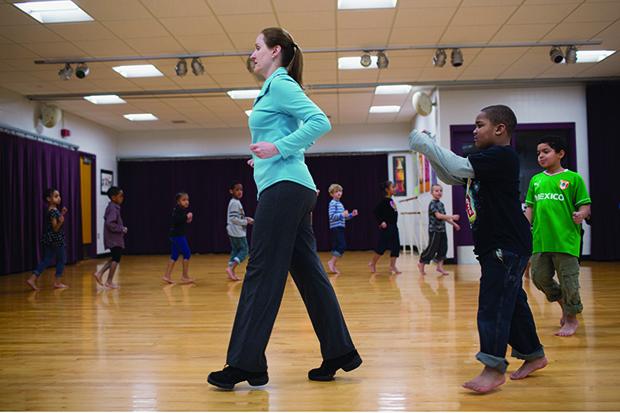But What About the Artists?

Deb Norton leads first-grade students in a dance exercise at Woods Lake Elementary in Kalamazoo, Michigan. Photo by Junfu Han, courtesy of Encore magazine
An occupational hazard of the social sciences is that we tend to generalize. Even when writing about the dynamic and complex system of arts and culture, it becomes tempting to treat the component parts as monoliths. Thus, when attempting to quantify the arts’ benefits to individuals and society, we often overlook the roles and relationships of different units that work in tandem to produce those effects.
For instance, we speak of the social and emotional learning (SEL) that derives from arts education. But where do teaching artists fit into the equation? How does their own vocational practice enable them to transmit SEL to others? Or we refer to the arts’ value for public health strategies. How do artists find themselves partnering effectively with organizations, in clinical and non-clinical settings, to build trust in community health providers?
Most conspicuously, we talk about the economic impacts of the arts—but how do we measure the opportunity costs for various sectors and communities that lack adequate support systems for artists?
It all sounds painfully schematic—using terms like “system,” “units,“ or “impacts” when discussing the arts. Know what’s worse? Neglecting to consider artists as central to any theoretical framework that might be used to launch a better and sustainable future for “the arts” nationwide.
In the darkest days of the pandemic, one often heard arts administrators pray not only that the sector would recover, but that it might experience a new birth. Yet without accounting for the distinctive characteristics and contributions of artists as workers, it’s hard to imagine a policy solution that will succeed in the dual task of rebuilding the creative economy and providing more equitable opportunities for those participating in it.
We can start by monitoring and seeking to address employment and income conditions for artists. From March to June 2021 (the most recent quarter for which data are available), the U.S. total unemployment rate fell to 5.4 percent, compared with 12.6 percent one year ago. Those figures also dropped for artists. Art directors, fine artists, and animators had a 19.7 percent unemployment rate in the second quarter of 2020, but now showed 8.6 percent. For architects, the new rate was even lower: 6.8 percent.
For performing artists, meanwhile, the rates remain high—though mercifully lower than in 2020. As of June 2021, 13.5 percent of musicians, 27.9 percent of dancers/choreographers, and 35.3 percent of actors were unemployed.
Even when they are working, performing artists earn far less, on average, than do many other types of artists. In a previous report, we showed that the median annual salary of U.S. artists is greater than that of the nation’s workers as a whole. This difference masks other differences. Although architects, producers/directors, and writers/authors all earn well above the median annual salary of workers in general, performing artists such as musicians, dancers/choreographers, actors, and “other entertainers” all earn somewhat below it. These lower-paying categories, in turn, are artist occupations in which non-White and Hispanic workers are more highly concentrated.
Such statistics carry more than academic value. They can be viewed as cautionary notes for arts funders and policy-makers in designing programs that seek to recruit artists for cross-sectoral purposes. By attending more closely to disparities in income and opportunity across artist occupation types, and across demographic subgroups, cultural planners can be more sensitive to the remunerative needs of artists they seek to engage in projects outside the arts sector.
These thoughts were prompted by by Megan Robinson’s (Vanderbilt University) and Jennifer Novak-Leonard’s (University of Illinois at Urbana-Champaign) article in the Spring 2021 issue of Artivate. The study, supported by a NEA Research Lab award, followed artists who participated in Periscope, an artist-entrepreneur training program offered by the Arts & Business Council of Greater Nashville. Robinson and Novak-Leonard explored how these artists’ entrepreneurial habits influenced their creative output and their perceptions of community.
According to the authors, a quarter of artist-entrepreneurs in the study found themselves “engaging with community as a natural element of their practice.” Nevertheless, “several others initiated loose attacks against funding structures that require artists to engage with community development, citing concerns about stretching their capacity, inequality of expectations between themselves and other entities also engaged in processes of community development, and burdening their creativity,” the authors add.
Robinson and Novak-Leonard go so far as to state: “The failure of communities, and specifically, funders, to recognize the primary entrepreneurial motivation of artists--a desire to maintain control of their creative process—while ignoring the considerable social good artists undertake in their practices, undermines the effort, training, skill, and labor involved in the production of art.”
By contrast, they write, “investing in artists via entrepreneurial training has the potential to yield artist-led community benefits and projects similar in class to creative placemaking initiatives, while simultaneously honoring the desire of entrepreneurial artists to maintain control of their input and product. The entrepreneurial artists in our sample demonstrated an ability to see and act upon opportunities in community on their own terms.”
In brief, the “capacity of entrepreneurial artists to be involved with the construction of community—through intentional planning or just by the nature of their work—is limited only by the degree to which artists are supported in their pursuit,” the authors claim. This sentence seems like a good way to herald Labor Day, and perhaps greater autonomy for artists in any transformative vision about the sector.




